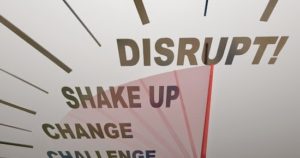The Power of Disruptive Thinking
0 comment
While I believe completely in the value of, and need for, nonprofits to have a strategic plan, the process and the plans themselves are, frankly, usually boring. Over the years of leading The Nonprofit Center, we’ve experimented with different approaches to strategic planning, always in search of alternative means for helping our clients with their own strategic planning. Of all of the different approaches we tried, the one I enjoyed the most (and probably the one others enjoyed the least) was planning with BHAGs—those big, scary audacious goals, courtesy of leadership expert Jim Collins. They inspire; they are not boring.
I stopped doing strategic planning consulting some time ago, but was reminded of that decision when I started thinking about disruptive thinking. And I got to disruptive thinking because of generative thinking, something so few understand. While I believe that both generative and disruptive thinking can get individuals and groups to the same result, the terminology of the latter is immediately more intuitive. Well-recognized in the for-profit sector, disruptive thinking in the nonprofit sector seems all but nonexistent in general, and specifically in the strategic planning process.
For the vast majority of nonprofits, the strategic planning process is a linear one, resulting in most strategic plans that tend to be more of the same, just bigger, or different locations, or a tweak here or there. So instead of deep purple, we get light violet. The line isn’t turned into a squiggle; it is simply extended. Change comes only in small increments. Every once in a while, there may be a participant in a group who can really think outside of that box. Too often, however, the others in the room, for whom that idea is too radical—too disruptive—pull the outlier down. The nonprofit sector is unlikely to survive, to be a robust contributor to the future well-being of people and communities, if we don’t start shaking things up.
Enter disruptive thinking. It rattles the cages. Disruptive thinking requires, first and foremost, a willingness to question the status quo. As I’ve noted before, nonprofits are too willing to settle for good enough instead of pushing to define what is best. Disruptive thinking requires that we let go of how things have always been done and think about possibilities. It requires that we take risks in our thinking, that we are, going back to Collins, audacious in our thinking. It necessitates letting go of the safety net of what is familiar and think about the unknown potential. It is, no doubt, what lead to the creation of everything you have ever referenced as, “I wish I had invented that!” Think Apple, Amazon, Velcro, and the list goes on.
It isn’t that the people involved in nonprofits aren’t creative, smart folk; its that too many are too scared—too scared to take calculated risks, too scared of making a mistake, too scared to disrupt the way things have always been done—even if the outcome might be monumentally better. Ultimately, though, they are too scared that a donor(s) might walk away.
And, yet, those who regularly invest in for-profit companies—be it through the stock market, as an angel investor or venture capitalist, etc.—know the risks, take the leap, and do so again and again. Sometimes they walk away richer, sometimes not, but they generally go on to invest again. Thus, surely those who invest in both for-profits and nonprofits understand the calculated risks involved in investing; they can calculate and weigh the risk that something exponentially better might come out of a disruptive idea or it may be a bust.
But for the sake of the bigger return—financial or social—the risk becomes acceptable. Thus, we should no longer fear that shaking up our status quo will shake loose donors. Rather, as we disrupt how we fulfill our mission promises, we must also disrupt how we tell our story.
The opinions expressed in Nonprofit University Blog are those of writer and do not necessarily reflect the opinion of La Salle University or any other institution or individual.

